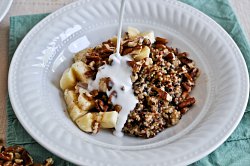All About Coconut Milk
Coconut milk is derived from the flesh of the coconut. It is not the liquid that can be drained out from a coconut that has been punctured, although many people assume this. Getting coconut milk from a coconut requires some processing, but the ingredient is also available in cans or bottles. Coconut milk is used as a cooking base in many recipes, particularly in the cuisine of Thailand and other South and Southeast Asian countries, but also in West Africa, Hawaii and the West Indies.
When a coconut is cut open, the flesh can be found all along its inner walls. A ripe coconut, ideal for processing into coconut milk, should have thick, creamy white flesh. If the flesh appears yellow, it is most likely rancid. A coconut with relatively thin, dry flesh can still be used to make milk, but the milk may not be creamy enough for certain recipes, particularly curries.
To make coconut milk, the coconut flesh must be finely grated and steeped in hot water. Next, the soaked pieces are squeezed through cheesecloth, and the liquid collected is coconut milk. This process may be repeated once or twice to produce lighter coconut milk, as different consistencies are required for different recipes. When the first pressing is allowed to sit for a while, coconut cream rises to the top. This ingredient is commonly used in desserts or rich sauces.
Canned and bottled coconut milk varies widely in quality, and most cooks have their own preferences. However, in general, a quality product will have a layer of thicker cream on the top and thinner milk on the bottom. The can may be shaken to produce a more uniform coconut milk if desired, or the cream may be removed and used for something else. Coconut milk must be refrigerated if not used immediately, as it will spoil otherwise.
While coconut milk is high in saturated fat, it is much healthier than other saturated fat products, and the fat is easily metabolized by the body. Coconut milk also offers some particular health benefits. It is anti-carcinogenic, anti-microbial, anti-bacterial, and anti-viral. The main saturated fat that it contains, lauric acid, is also found in mother’s milk and has been shown to promote brain development and bone health.
Coconut Milk Breakfast Quinoa

Ingredients
- 1/2 cup dry quinoa, rinsed
- 3/4 cup canned lite coconut milk + more for drizzling
- 2 teaspoons vanilla extract
- 1/2 teaspoon cinnamon + more for sprinkling
- pinch of salt
- 1 banana, chopped
- 1/3 cup toasted pecans, chopped
Instructions
Combine quinoa, coconut milk, cinnamon and vanilla in a small saucepan and bring to a boil. Reduce to a simmer, cover, and let cook for 15 minutes until quinoa can be fluffed with a fork.
Divide quinoa into two bowls then cover with bananas, pecans, and a few extra drizzles of coconut milk.
Note: you can definitely use full-fat coconut milk. Additionally, feel free to add sugar or sweetener if needed, although it is naturally sweet with the coconut milk and fruit.
Serves: 2
The Standing Side Stretch

(A) Stand with your feet together and your arms straight overhead. Clasp your hands together, with your fingers interlaced and pointer fingers extended. Inhale as you reach upward.
(B) Breathe out as you bend your upper body to the right. Take five slow breaths. Slowly return to the center. Repeat on the left side.





